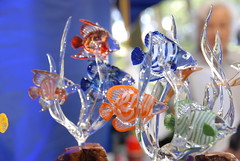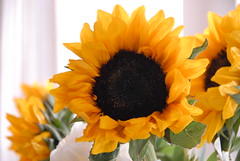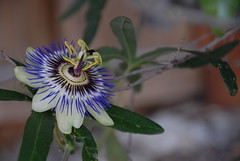This was displayed in one of the stalls at the Art and Wind festival. The depth of vision and the blue color gives a good effect to this photo.
Random thoughts about happenings around me -- past, present and hopefully future. Most of the write ups are about things that have happened in my life and I remember (or whatever I remember).
Wednesday, May 30, 2007
Monday, May 28, 2007
Memories of Kite flying and San Ramon Art and Wind Festival
I was at the San Ramon Art and Wind Festival today. It was a joy to see the fair and the community spending some time out in the beautiful weather on the grounds of the Community Central Park.
It also reminded me of the days I spent in India flying the kites. My father never liked my flying the kite – he was worried I’d fall over from the terrace or run myself under a truck while chasing down the road to catch a kite
down the road to catch a kite (and believe me, I have seen this happen a few times). In India, kite flying used to be a craze!! We would have kite fights or Painch (pronounced Pain-ch), as it was called --- where one kite would “fight” another till the string of the loser were cut and then the losing kite would float away, with a whole bunch of kids chasing the floating kite, down the road.
(and believe me, I have seen this happen a few times). In India, kite flying used to be a craze!! We would have kite fights or Painch (pronounced Pain-ch), as it was called --- where one kite would “fight” another till the string of the loser were cut and then the losing kite would float away, with a whole bunch of kids chasing the floating kite, down the road.
‘Dheel’ or Release cutting, letting out as much line as possible, was used more often when flying the larger fighter kites. In this form, the weight of the kite and its stability were more important. Kites were flown long distances, often well over 3,000 feet. The flier needed to keep the kite stable so that it could take out more line. The kite that could release more line quickly usually had the advantage over the other fighters.
With the larger kites, there were usually two people involved in the flying of an individual kite, and both were equally busy. While one person controlled the kite, and kept it steady, the other held the spool and was responsible for the line, making sure that there was a sufficient flow of line for the kite.
Either way, the 2 kites would move so that their strings would slide against each other, in a saw like motion. The only way to win a fight was to make a stronger string. So, we all would try and “make” the strongest “maanjha” – as the string was called to fly the kite.
To make the stronger Maanjha, either we would have to make it a smooth slider thread or make it abrasive enough to slice the other Maanjha. Maanjha is the thread line, cured with a special mix of glue and ground glass. Since a lot depends on the sharpness of the string to which the kite is attached, a lot of effort is normally put in making the maanjha. A combination of herbs, glass powder, sand and glue are applied to thick ordinary string to sharpen it. Our maanjha was made by using crushed glass mixed with glue to create a razor sharp maanjha to cut the strings of the all the enemies in the sky. To make a smoother maanjha, we would use things like okra, arbi (colocasia, taro root), apart from finely crushed glass, glue, and color etc. All the boys in the neighborhood would get together on a holiday, to make the maanjha. It was a whole day event and every one was given specific tasks – mixing color, grinding glass, moving the glass or the gliding herbs over the string as some one walked with it and moved it in the air to dry it.
Then, we climbed up to our roof top and got into kite-fights against all the other kids flying their kites from their rooftops. The sky would be filled with dozens of kites in aerial dogfight. The event was fun filled and involved the entire neighborhood. But, now that I think of it that was the way the life was then – fun-filled and something to involve the community. There was no TV, no Wii or Play Station, No computer – it was all fun and games outside the house. And I loved it – so much so that it has left an indelible mark in my memory. The art and wind festival I saw today also brought the community out and people organized picnics. There were cultural dances from all cultures -- I saw the hula, the belly dance, the bharat natyam and lot of other thing -- I enjoyed it a lot, but my childhood kite fights were more fun!!!
It also reminded me of the days I spent in India flying the kites. My father never liked my flying the kite – he was worried I’d fall over from the terrace or run myself under a truck while chasing
 down the road to catch a kite
down the road to catch a kite (and believe me, I have seen this happen a few times). In India, kite flying used to be a craze!! We would have kite fights or Painch (pronounced Pain-ch), as it was called --- where one kite would “fight” another till the string of the loser were cut and then the losing kite would float away, with a whole bunch of kids chasing the floating kite, down the road.
(and believe me, I have seen this happen a few times). In India, kite flying used to be a craze!! We would have kite fights or Painch (pronounced Pain-ch), as it was called --- where one kite would “fight” another till the string of the loser were cut and then the losing kite would float away, with a whole bunch of kids chasing the floating kite, down the road. Obviously, every kite flyer wanted to win the fight. There were two ways to fight an opponent’s kite – either you pull a string or you let the string slide.
The “kheech” or Pull was usually favored when flying with the smaller fighters because they were lighter and more maneuverable. In this form, the agility and moderate weight of the kites, and skill of the kite flyer was more important. The kite was flown to a certain distance in the sky, about 1000 feet and usually ahead of the other fighter kites. When ready to fight, the flier then began pulling on his line as quickly as possible at the same time trying to cut any kite lines that were in the path of his line. Experienced fliers could cut the opponents line from either the top or bottom, and even from the side.‘Dheel’ or Release cutting, letting out as much line as possible, was used more often when flying the larger fighter kites. In this form, the weight of the kite and its stability were more important. Kites were flown long distances, often well over 3,000 feet. The flier needed to keep the kite stable so that it could take out more line. The kite that could release more line quickly usually had the advantage over the other fighters.
With the larger kites, there were usually two people involved in the flying of an individual kite, and both were equally busy. While one person controlled the kite, and kept it steady, the other held the spool and was responsible for the line, making sure that there was a sufficient flow of line for the kite.
Either way, the 2 kites would move so that their strings would slide against each other, in a saw like motion. The only way to win a fight was to make a stronger string. So, we all would try and “make” the strongest “maanjha” – as the string was called to fly the kite.
To make the stronger Maanjha, either we would have to make it a smooth slider thread or make it abrasive enough to slice the other Maanjha. Maanjha is the thread line, cured with a special mix of glue and ground glass. Since a lot depends on the sharpness of the string to which the kite is attached, a lot of effort is normally put in making the maanjha. A combination of herbs, glass powder, sand and glue are applied to thick ordinary string to sharpen it. Our maanjha was made by using crushed glass mixed with glue to create a razor sharp maanjha to cut the strings of the all the enemies in the sky. To make a smoother maanjha, we would use things like okra, arbi (colocasia, taro root), apart from finely crushed glass, glue, and color etc. All the boys in the neighborhood would get together on a holiday, to make the maanjha. It was a whole day event and every one was given specific tasks – mixing color, grinding glass, moving the glass or the gliding herbs over the string as some one walked with it and moved it in the air to dry it.
Then, we climbed up to our roof top and got into kite-fights against all the other kids flying their kites from their rooftops. The sky would be filled with dozens of kites in aerial dogfight. The event was fun filled and involved the entire neighborhood. But, now that I think of it that was the way the life was then – fun-filled and something to involve the community. There was no TV, no Wii or Play Station, No computer – it was all fun and games outside the house. And I loved it – so much so that it has left an indelible mark in my memory. The art and wind festival I saw today also brought the community out and people organized picnics. There were cultural dances from all cultures -- I saw the hula, the belly dance, the bharat natyam and lot of other thing -- I enjoyed it a lot, but my childhood kite fights were more fun!!!
Labels:
"art and wind",
festivals,
India,
Indian,
Kite,
Kite fights,
Maanjha,
Memories,
San Ramon,
Sandeep
Sunday, May 20, 2007
First Passion flower
Friday, May 18, 2007
Catching soap bubbles
My sister playing with some soap bubbles my kids were blowing out. Canon A80 was the camera used for this. The joy on her face shows age is not a limitation to enjoy small things like this.
Subscribe to:
Posts (Atom)



